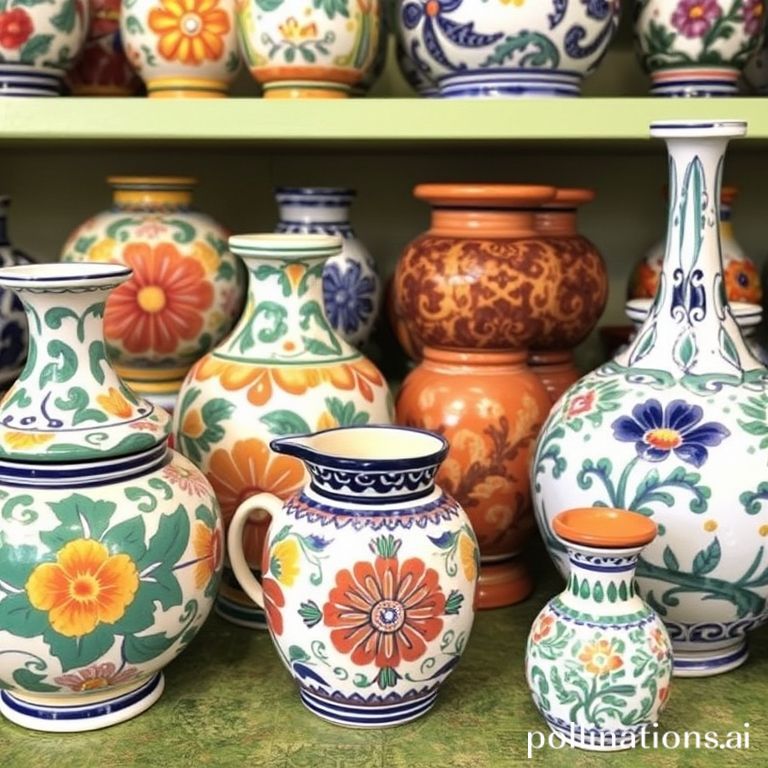Talavera pottery, with its vibrant colors and intricate designs, is more than just decorative art; it’s a living piece of Mexico’s rich cultural heritage. Originating in Puebla, Mexico, this exquisite type of earthenware has a history that intertwines Spanish and indigenous influences, resulting in a unique and highly sought-after art form. Whether you’re a seasoned collector or simply looking for a beautiful souvenir, understanding the nuances of Talavera pottery will enhance your appreciation for this iconic craft.
This guide explores the history, production, and characteristics of authentic Talavera pottery, providing you with the knowledge to identify genuine pieces and appreciate the artistry behind them.
The History of Talavera Pottery
The story of Talavera pottery begins in the 16th century when Spanish artisans, primarily from Talavera de la Reina in Spain, brought their pottery techniques to Mexico. Puebla, with its abundant clay deposits and skilled indigenous artisans, quickly became the center of Talavera production in the New World. The fusion of Spanish methods with local artistic sensibilities led to the creation of a distinct Mexican style. Over time, indigenous designs and motifs were incorporated, giving Talavera pottery its unique identity.
During the colonial period, Talavera pottery adorned churches, convents, and wealthy homes, showcasing its importance in Mexican society. The style evolved, influenced by various artistic movements, but always maintained its characteristic vibrant colors and detailed hand-painted designs.
The Making of Authentic Talavera
Creating authentic Talavera pottery is a meticulous and time-consuming process that adheres to strict guidelines. Here’s a glimpse into the traditional methods:
Clay Preparation
- The process starts with selecting the right type of clay, typically a blend of black and pink clay found locally in the Puebla region.
- The clay is then carefully mixed, cleaned, and left to settle for several weeks to achieve the perfect consistency.
Shaping and Firing
- The clay is shaped by hand on a potter’s wheel or using molds, depending on the desired form.
- Once shaped, the pottery is left to dry completely before the first firing, known as the “jahuete.” This initial firing hardens the clay and prepares it for glazing.
Glazing and Painting
- After the first firing, the pottery is covered with a white glaze made from tin, lead, and silica.
- The intricate designs are then hand-painted onto the glazed surface using mineral-based pigments. The traditional colors include blue, yellow, black, green, and orange, each derived from specific minerals.
Second Firing
- Finally, the painted pottery undergoes a second firing at a higher temperature, which fuses the glaze and pigments to create a durable and glossy finish.
Identifying Authentic Talavera Pottery
With the popularity of Talavera pottery, it’s essential to know how to distinguish genuine pieces from imitations. Here are some key characteristics to look for:
- Origin: Authentic Talavera pottery must be produced in the designated region of Puebla and surrounding areas.
- Materials: It should be made using traditional clay and glazes.
- Hand-Painted Designs: The designs are always hand-painted, never mass-produced or printed. Look for slight imperfections, which are a sign of authenticity.
- “Talavera” Mark: Genuine pieces often bear the maker’s mark or the “Talavera” designation.
- Crazing: Fine cracks in the glaze (crazing) are common in authentic Talavera due to the firing process and are not necessarily a sign of damage.
Caring for Your Talavera Pottery
To preserve the beauty of your Talavera pottery, follow these simple care tips:
- Hand wash with mild soap and water. Avoid harsh chemicals or abrasive cleaners.
- Dry thoroughly after washing.
- Avoid sudden temperature changes, which can cause the glaze to crack.
- When displaying Talavera pottery, keep it away from direct sunlight to prevent fading of the colors.
Conclusion
Talavera pottery is a testament to the enduring legacy of Mexican artistry and craftsmanship. Its vibrant colors, intricate designs, and rich history make it a cherished art form. By understanding the origins, production methods, and characteristics of authentic Talavera, you can appreciate the true value of these beautiful pieces and proudly own a piece of Mexican heritage.
If you enjoyed this article, don’t forget to explore more inspiring stories on Life in Mexico!
IMAGE: A brightly lit, close-up studio shot of several pieces of Talavera pottery from Puebla. The pieces include plates, bowls, and a vase, all featuring intricate hand-painted designs in vibrant blue, yellow, orange, green, and black colors. The background is a soft, blurred white to emphasize the pottery. The style is artistic and inviting, showcasing the beauty and craftsmanship of Talavera.


